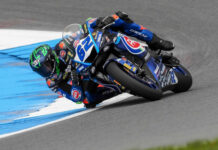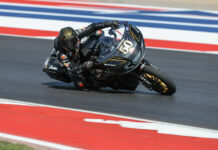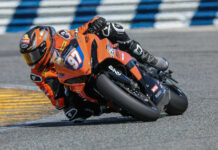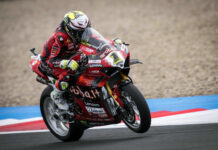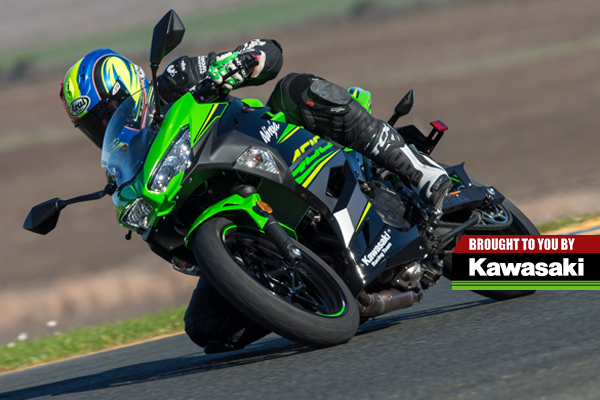This featured article is brought to you by Kawasaki Motors Corp., U.S.A. (KMC). KMC markets and distributes Kawasaki motorcycles, ATVs, side x sides, and Jet Ski® watercraft through a network of almost 1,100 independent retailers, with close to an additional 7,400 retailers specializing in general purpose engines. KMC and its affiliates employ nearly 3,100 people in the United States, with approximately 260 of them located at KMC’s Foothill Ranch, California headquarters. Kawasaki’s tagline, “Let the good times roll.®”, is recognized worldwide. The Kawasaki brand is synonymous with powerful, stylish and category-leading vehicles. Information about Kawasaki’s complete line of powersports products and Kawasaki affiliates can be found on the Internet at www.kawasaki.com.
By David SwartsCopyright Roadracing World Publishing, Inc.
The new Junior Cup class coming to the MotoAmerica AMA/FIM North America Road Racing Series in 2018 is creating high expectations for a variety of reasons.
In 2015-2016-2017, MotoAmerica ran a one-make/one-model entry-level class, making it possible for riders as young as 14 to race regularly on the largest stage in American motorcycle road racing and do it at a relatively low cost. The KTM RC Cup was a success, drawing larger grids than anticipated (up to 30 entries at times), providing entertaining racing for fans at the track and at home via beIN Sports’ video coverage, and offering young riders the opportunity to prove themselves, earn new opportunities, and move up the racing ranks.
For 2018, MotoAmerica is introducing the Junior Cup, which is modeled after the FIM Supersport 300 World Championship introduced last season. The new Junior Cup will be open to riders between the ages of 14 and 25 (up from 22 last year). The biggest change, however, is that the new Junior Cup will be open to any manufacturer that chooses to homologate an eligible, small-displacement sportbike.
“It is our hope that opening up the class to other manufacturers should bring a broader base of participants into MotoAmerica and create more opportunities for riders, manufacturers and teams,” MotoAmerica President Wayne Rainey said in announcing the Junior Cup.
Which motorcycles are eligible for the Junior Cup? Any motorcycle that fits within Europe’s A2 tiered licensing system, and that means any motorcycle that produces 46.9 horsepower (35 kw) or less in stock form.
So motorcycles that are eligible to race in MotoAmerica’s Junior Cup include Kawasaki’s new Ninja 400 and Ninja 300; KTM’s RC 390 and new RC 390 R; Yamaha’s YZF-R3; Honda’s CBR500R; BMW’s G 310 R; Ducati’s Scrambler Sixty2; and Suzuki’s GSX250R Katana.
That’s a wide range of machines, including Twins – both air-cooled and water-cooled – from 249cc to 471cc and Singles from 313cc to 373cc, but MotoAmerica officials say they will balance the performance of the various machines by using minimum weight limits and maximum engine rev limits controlled by mandated parts. And to keep the class competitive and affordable, the Junior Cup will limit modifications, the number of Dunlop spec tires used per weekend, and mandate the use of Sunoco Apex race fuel.
And just as Rainey hoped, the new Junior Cup has attracted more attention from motorcycle manufacturers, which have posted significant amounts of contingency money to make it more attractive for racers to purchase and compete with their motorcycles, including as much as $2,500 to win a single race and $15,000 to win the Championship. That’s not bad money for a teenage racer!
Here’s a breakdown of the motorcycles that are eligible for MotoAmerica’s Junior Cup.
Kawasaki Ninja 400 and Ninja 300

Kawasaki’s impressive new 2018 Ninja 400 has been homologated for racing in the FIM Supersport 300 World Championship and the new MotoAmerica Junior Cup class. Kawasaki is offering a large amount of contingency money to riders who win races on Ninja 400s and Ninja 300s in 2018. – Photo by Kevin Wing.
Kawasaki has two models eligible and homologated for competition in MotoAmerica Junior Cup: The all-new 2018 Ninja 400, and the Ninja 300, which was introduced in 2013. Both machines have high-tensile steel-tube frames and are powered by liquid-cooled, Parallel Twin engines with double overhead camshafts and four valves per cylinder, but the engine displacements are obviously different, 296cc for the Ninja 300 and 399cc for the Ninja 400. The all-new Ninja 400 engine is about the same physical size and weight of the Ninja 300 engine, but makes 36% more horsepower (45 vs. 33 at the rear wheel) and 47% more torque (25 vs. 17 lbs.-ft.)! And if that weren’t enough, the new Ninja 400’s claimed curb weight, 361.5 pounds (164 kg), is nearly 18 pounds (8.2 kg) lighter than the Ninja 300, and the bike handles well!
This presents a perfect opportunity to examine the balancing rules in MotoAmerica Junior Cup, as the Ninja 300 in race trim has a lower minimum weight limit of 308 pounds (140 kg) and a higher rev limit of 13,000 rpm compared with the Ninja 400’s 330 pounds (150 kg) and 12,000 rpm limit. (Editorial Note: Since this article was originally published, FIM and MotoAmerica have changed the maximum rpm limit of the Ninja 400 to 10,000 rpm and its minimum weight limit to 145 kg or 319 pounds.)

Kawasaki riders won three races and took third in the 2017 FIM Supersport 300 World Championship. Here, Harun Cabuk (54), riding a Kawasaki Ninja 300, leads Yamaha YZF-R3 riders Enzo De La Vegas (14), Dorren Loureiro (hidden behind Cabuk) and Mykyta “Nick” Kalinin (22) during the 2017 FIM Supersport 300 race in Portugal.
Kawasaki is supporting both machines with its Team Green program, which includes dealer support opportunities and strong contingency money postings. For 2018, Kawasaki has posted contingency prizes of $2,500 for 1 st, $1,000 for 2nd, $750 for 3rd, $600 for 4 th, and $500 for 5th in each and every Junior Cup race, for a total of $90,950 at MotoAmerica events. In addition to that, a rider can earn up to $500 for winning any one of dozens of club races across the country on a 2018 Ninja 400 or 2017 Ninja 300, both of which have a Manufacturer’s Suggested Retail Price (MSRP) of $4,999 for non-ABS versions.
When you take all of that into consideration plus the fact that riders on the Ninja 300 won three races and finished third in the 2017 FIM Supersport 300 World Championship, the green machines—especially the new Ninja 400–look to be very competitive this season.
KTM RC 390 and RC 390 R

KTM’s RC 390 has been raced in the one-make KTM RC Cup around the world and in MotoAmerica for the last three years. Now, KTM is turning its attention to the FIM Supersport 300 World Championship and the MotoAmerica Junior Cup with a new homologation special, the 2018 KTM RC 390 R. – Photo by CaliPhotography.com.
KTM’s RC 390 features a tubular steel trellis frame, 43 mm inverted forks, a radial-mount front brake caliper, low overall weight, and a strong 373cc single-cylinder engine. But the KTM was not a factor in the 2017 FIM Supersport 300 World Championship because the Austrian manufacturer was focused on supporting its RC Cup series, which raced in several different countries over the last three years.
For 2018, however, not only has KTM turned its attention to classes like Supersport 300 and the Junior Cup, the company has developed a homologation special model, the RC 390 R, and a special SSP 300 Race Kit of over 200 parts (which will also work with 2017-model RC 390s). Although the RC 390 and RC 390 R share the same engine, the rule makers at FIM and MotoAmerica have not yet said whether or not the R model will share the RC 390’s 299-pound (136 kg) minimum weight limit and 11,000-rpm maximum rev limit. (Editorial Note: Since this article was originally published, FIM and MotoAmerica have changed the KTMs’ maximum rpm limit to 10,000 rpm and raised its minimum weight limit to 142 kg or 312.4 pounds.)

KTM is offering a SSP 300 Race Kit, including over 200 parts, to go with its 2018 RC 390 R homologation special.
The 2018 RC 390 R (MSRP $8,499), RC 390 (MSRP $5,499) and SSP 300 Race Kit (MSRP $10,999) do not come cheap, but a race-kitted RC 390 R may be a potent weapon. And to further support their product in the MotoAmerica Junior Cup, KTM North America has posted $25,500 in contingency prizes through its Orange Brigade program, including $500 to win each race, plus Championship bonuses of $15,000 for 1 st, $7,500 for 2 nd, and $3,500 for 3rd.
Yamaha YZF-R3

Yamaha and Graves Motorsports have teamed up to offer turn-key Yamaha YZF-R3 racebikes built specifically for racing in MotoAmerica Junior Cup. Here, racer Chase Lyons (13) tries out his new YZF-R3 on track.
The Yamaha YZF-R3 attracted the most riders, won the most races, and claimed the title in the 2017 FIM Supersport 300 World Championship. Powered by a liquid-cooled, DOHC, 321cc Parallel Twin engine fitted into a capable chassis, the YZF-R3 was an attractive machine literally and figuratively because Yamaha Motor Europe strongly supported the machine and its racers in Supersport 300, where it was limited to 12,850 rpm and had to weigh at least 308 pounds (140 kg). (Editorial Note: Since this article was originally published, FIM and MotoAmerica have changed the maximum rpm limit to 13,000 rpm, have lowered the minimum weight limit to 138 kg or 303.6 pounds, and have allowed the airbox of the Yamaha to be modified.)
Now, Yamaha Motor Corp., U.S.A. is doing the same thing here with its bLU cRU racing department and a new Graves/Yamaha YZF-R3 Support Program. The Graves/Yamaha YZF-R3 Support Program offers racers the opportunity to buy a turn-key YZF-R3 racebike built to the limit of the restrictive MotoAmerica Junior Cup rules, and it comes with technical support at the track, and personal coaching throughout the season from program mentor and four-time AMA Superbike Champion Josh Hayes.
And whether a rider purchases a Graves/Yamaha YZF-R3 racebike for $14,953.52 (which includes a parts credit of $3,000) or purchases a standard YZF-R3 from a dealer for $4,999 and builds their own racebike, all bLU cRU riders will be eligible to earn some of $25,500 total racing contingency money posted for MotoAmerica Junior Cup races — $500 for 1 st, $400 for 2nd, $300 for 3rd, $200 for 4 th, and $100 for 5th – as well as at club races across the country.
Honda CBR500R

Mika Perez (88) won two races and finished fourth in the 2017 FIM Supersport 300 World Championship on his Honda CBR500R. Here, Perez chases Anna Carrasco (2) at Portimao in 2017; Carrasco won the race on her Kawasaki Ninja 300.
It may seem odd that Honda’s CBR500R (which sells for $6,599) is allowed in the Supersport 300 World Championship and the MotoAmerica Junior Cup, especially considering Honda has a CBR300R, but as mentioned above, the CBR500R is legal for A2-licensed riders in Europe and it competes with the others where it counts the most – dealership showrooms.
Still, race officials have used the balancing rules the most with the CBR500R, limiting its liquid-cooled, DOHC, 471cc Parallel Twin engine to 9,500 rpm while the entire motorcycle in race trim has to weigh at least 343 pounds (156 kg). That weight limit has gone up from 330 pounds (150 kg) in 2017, when the Honda CBR500R won two races and finished fourth in the Supersport 300 World Championship. (Editorial Note: Since this article was originally published, FIM and MotoAmerica have changed the maximum rpm limit to 10,000 rpm and now allow the airbox of the CBR500R to be modified.)
While Honda’s CBR500R may or may not be the first machine to come to mind when thinking about MotoAmerica Junior Cup racing, it’s worth noting that more contingency money is available from Honda’s Red Rider Rewards program than from any other manufacturer’s Junior Cup contingency program. Not only is Honda offering $2,500 for each race won on a CBR500R, Honda has posted contingency prizes down to 10 th place and a total of $9,250 for each and every MotoAmerica Junior Cup race. That’s $157,250 for the entire 17-race Junior Cup season, not to mention the contingency that can be earned at club race events.
Others
As mentioned above, several other manufacturers have motorcycles that are eligible for the MotoAmerica Junior Cup.
BMW’s G 310 R ($4,750) comes with a liquid-cooled, DOHC 313cc single-cylinder engine in a chassis that includes 41 mm inverted front forks.

BMW’s new G 310 R sportbike, which is powered by a 313 cc single-cylinder engine, is eligible for MotoAmerica’s Junior Cup, but it has not been homologated by BMW Motorrad.
Ducati’s Scrambler Sixty2 ($7,995) is powered by an air-cooled 399cc V-Twin with two valves per cylinder in a 400-pound (claimed wet weight) package.

Ducati’s Scrambler Sixty2, which is powered by an air-cooled 399cc V-Twin, is also eligible for the MotoAmerica Junior Cup, but has not been homologated by Ducati.
And Suzuki’s GSX250R Katana ($4,549) features a liquid-cooled, fuel-injected, SOHC 248cc Parallel Twin with a sporty chassis.

Roadracing World’s Chris Ulrich at speed with a 2018 Suzuki GSX250R Katana on the racetrack. It hasn’t been homologated.
BMW, Ducati, and Suzuki, however, have not yet decided to homologate these models for racing in MotoAmerica’s Junior Cup.
Other MotoAmerica Junior Cup Facts:
The Junior Cup will have a schedule similar to what the KTM RC Cup had in the past, including practice and provisional qualifying on Friday, final qualifying and a race on Saturday, and a second race on Sunday at most MotoAmerica events.
The Junior Cup will not race at Circuit of The Americas and will race only once at Mazda Raceway Laguna Seca during the shared MotoAmerica/World Superbike event. The Junior Cup will race twice at the remaining eight events, resulting in a 17-race season.
Junior Cup racebikes will have yellow number plates.
Junior Cup racers will be allowed to use a maximum of six, made-in-America Dunlop Sportmax Q3+ tires per race weekend.
Junior Cup races will be a minimum of 20 miles in length, (about 8-9 laps at most MotoAmerica tracks), or a maximum of 40 miles.
Engine: The only engine modifications allowed include installing a thinner head gasket to increase compression; using slotted camshaft sprockets to adjust cam timing; installing aftermarket air filters to improve air flow; modifying or replacing the exhaust system to reduce weight and make more power; and reprogramming the engine control electronics or using a MotoAmerica-approved piggyback fuel-injection module.
Transmission: Allowed modifications to the transmission include undercutting engagement dogs and treating gear surfaces; replacing the shift star and detent; installing aftermarket drive chain and sprockets; and fitting a mandatory MotoAmerica-approved quick-shifter/rev-limiter.
Chassis: The standard frame, swingarm, triple clamps, shock linkage, outer fork legs, brake master cylinders, and wheels must be used and not modified. The shock and fork internals can be replaced with aftermarket components that are approved by MotoAmerica and meet the price cap ($795 for fork kits, $979 for shocks). Brake pads and discs can be replaced with aftermarket products, with restrictions, and light alloy caliper pistons can be swapped out for steel pistons made by the same manufacturer. Any foot and hand controls can be used. An aftermarket battery can be installed as long as it can power the electric starter to start the motorcycle. And the bodywork can be replaced, but not the fuel tank.
To learn more about MotoAmerica, see the 2018 schedule, or to buy tickets, go to www.motoamerica.com.


